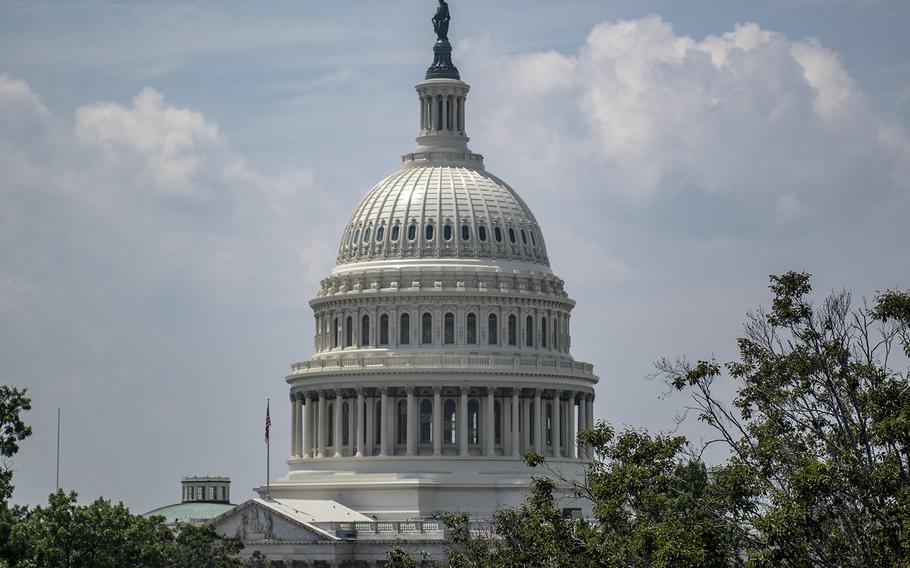
The U.S. Capitol seen on Aug. 7, 2018. Members of Congress on Thursday, Sept. 13, were moving ahead on a spending measure to avert a government shutdown. (Carlos Bongioanni/Stars and Stripes)
WASHINGTON — A massive defense spending measure that would direct more than $670 billion towards a wave of Defense Department increases, including the largest boost to servicemembers’ pay in nearly a decade and new gains in the number of troops, equipment and weapons for the 2019 fiscal year, could see passage on the House floor this week.
The effort is part of a so-called “minibus” appropriations measure, H.R. 6157, a larger package of more than $850 billion to fund labor, health and human services and education priorities. It will also fund priorities directed in the 2019 National Defense Authorization Act.
The defense budget moves on two tracks: the annual NDAA directs policy and spending plans for the military, while the defense appropriations bill is what actually moves money to the Pentagon.
President Donald Trump signed the 2019 NDAA, H.R. 5515, into law Aug. 13, which ushered through a series of new policy reforms, such as revamping the military’s “up or out” promotion system and policies to reign in sexual misconduct and domestic abuse among the ranks. The $716 billion NDAA also authorizes a 2.6 percent pay raise for servicemembers, as well as new purchases of aircrafts, ships, submarines and weapons.
The NDAA directs funding for Defense Department, as well as atomic energy defense activities under the Energy Department. Because it funds additional agencies, the NDAA directs larger spending priorities than its appropriations counterpart legislation, H.R. 6157, said Andrew Sherbo, a University of Denver finance professor who has tracked government and defense budget issues.
Rep. Mac Thornberry, R-Texas, chairman of the House Armed Services Committee, said Tuesday that he was confident the legislation would pass on the House floor this week and be signed into law by Trump in time for the start of the 2019 fiscal year on Monday.
“I don’t think there will be a veto… He’s been very consistent about rebuilding the military from beginning to end and this is the biggest single step we can take to rebuilding the military,” Thornberry told reporters in a briefing. And “there have been regular conversations between House and Senate leadership and the president for weeks, if not months, about what happens the last week in September.”
But several times this year, Trump has threatened a veto of spending measures if Congress doesn’t approve significant funding for a southern border wall, a move that could trigger a government shutdown.
“If it happens, it happens,” Trump has said about a shutdown. “If it’s about border security, I’m willing to do anything. We have to protect our borders.”
A veto could set into motion a dramatic turn of events. At the end of this week, the House is slated to go into recess until the November midterm elections, Thornberry said.
“I understand the president is frustrated about other appropriations that are not part of this, but I believe he will sign [H.R. 6157] and I believe it will be a major achievement – as weird as that sounds – to actually get our work done on time in a way that benefits the military so much,” Thornberry said.
If the defense spending measure is passed by Monday, it would mark the first time in about 10 years that the Defense Department won’t operate under a temporary funding measure, otherwise known as a continuing resolution, for the start of its fiscal year.
The Senate last week approved the compromise legislation in a vote of 93 to 7, sending the measure to the House. The House could vote for its approval as early as Wednesday.
H.R. 6157 includes a continuing resolution to fund agencies that aren’t covered by the minibus appropriations bill until Dec. 7 to avert a partial government shutdown.
Lawmakers have lauded the plan’s boost to pay, troop levels, funding of 13 new Navy ships, 93 F-35 aircraft, 18 C-130J aircraft, 58 UH-60 Black Hawk helicopters, 13 V-22 aircraft and the upgrade of 135 Abrams tanks.
They have also praised the measure’s efforts to fund research and development of new defense systems and technologies, including the F-35 Joint Strike Fighter, nuclear force modernization and the Ohio-class submarine replacement. The bill also funds above the president’s request for cancer research, traumatic brain injury research and sexual assault prevention.
The plan builds on the momentum to increase the size and might of the military in response to China and Russia’s growing capabilities as laid out in Trump’s defense budget proposal earlier this year. The Trump request for the fiscal year included an increase of more than 15,000 active-duty troops, which lawmakers matched in the NDAA.
A two-year spending deal that lifted federal budget caps allowed the defense budget to expand. Coupled with approaching November midterm elections, lawmakers worked to pass the bills earlier than in past years.
However, lawmakers remain on a tight clock. Without a spending measure in place by Monday, lawmakers might need to pass a continuing resolution, to keep the government operating.
During Thornberry’s briefing Tuesday, he also lauded moves towards the creation of a “Space Force,” supported recent comments on potentially ramped up U.S. presence in Syria, and lamented the Army’s recent miss on recruiting goals. And even in the face of rising U.S. debt and deficits, the House Armed Services Committee is ready to hold a Wednesday hearing to examine the correlation between a strong military and a prosperous economy.
“Economic growth, to have that, requires military strength,” Thornberry said.
grisales.claudia@stripes.com Twitter: @cgrisales